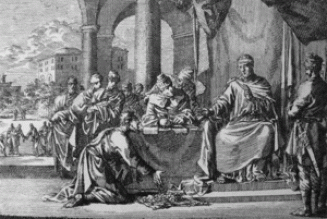 |
The fact that Shakespeare was a believing Catholic in very anti-Catholic times can be proven beyond any reasonable doubt. The evidence is convincing in terms of what is known about his life and from what can be seen in his plays and poems. Since this is so, it’s intriguing to consider Shakespeare’s response to the infamous Gunpowder Plot, the so-called “papist plot” to blow up the king and Parliament which was discovered in November 1605.
Let’s look at the events leading up to the plot and the way that Shakespeare responded to them, commencing with the Essex Rebellion in 1601. Led by the Earl of Essex and supported by Shakespeare’s patron, the Earl of Southampton, this abortive attempt to seize control of Queen Elizabeth’s government from the faction led by Robert Cecil almost certainly had Shakespeare’s support. This is evident in the first instance by the fact that the Earl of Essex’s sympathizers went to the Globe Theatre on the eve of the rebellion to persuade the Lord Chamberlain’s Men, the theatrical company for which Shakespeare wrote many of his plays, to stage Shakespeare’s Richard II, stipulating that the deposition scene be included. This scene, which had been banned by the government, shows sympathy for those nobles, such as Bolingbroke, who had rebelled against King Richard, dramatizing the king’s forced abdication. It was clearly hoped that the staging of the play might prove to be political dynamite, igniting the people of London against the queen and her ministers. Even though the rebellion failed, Queen Elizabeth was in no doubt that the staging of Shakespeare’s play had been intended to turn the people against her. “I am Richard II,” she told Sir William Lambarde, “know ye not that?”
As the Earl of Southampton languished in the Tower of London, imprisoned for his part in the rebellion, Shakespeare vented his spleen against the Elizabethan regime in the writing of Hamlet. There is a veiled reference to the queen herself in the allusion to her notorious use of thick white paint to mask her age. “Now get you to my lady’s chamber,” Hamlet says to the skull of Yorick, “and tell her, let her paint an inch thick, to this favour she must come [i.e., to death]; make her laugh at that.” It is, however, Elizabeth’s spy network, overseen by her spymaster, Sir Robert Cecil, which takes the brunt of Shakespeare’s anger, rather than the queen herself. Cast in the role of Polonius in the play, Cecil is shown to be a self-serving Machiavellian relativist, as are those spies who do his bidding. This anger against Elizabeth’s spy network, which is vented throughout the play, is expressed in theological terms in the famous graveyard scene in which Hamlet presents us with a memento mori resonant with intertextual references to a poem, “Upon the Image of Death”, by the Jesuit martyr, St. Robert Southwell, whom Shakespeare knew well and whose betrayal by one of Elizabeth’s spies led to his arrest, imprisonment, torture, and execution.
Shakespeare’s thrusting of the skull of Yorick into the face of the aging queen, albeit only allusively, was an indication that Elizabeth was soon to die. Knowing that the elderly queen could not live for much longer, England’s Catholics awaited the accession to the throne of James, who was married to a Catholic and who had hinted that he would cease the persecution which Catholics had suffered under Elizabeth.
After he succeeded Elizabeth to the throne, James kept his promise, once again enabling Catholics to practice their religion openly. Many were astonished at how many people still believed in the true faith, which had survived as an underground church through decades of state-sponsored persecution. During this all too brief honeymoon period, the Catholics of England must have felt a great sense of elation at the freedoms they now enjoyed, much as the people of the Soviet Union must have felt elated at the restoration of freedom after decades of tyranny. As for Shakespeare’s own response, the title of the play he wrote during this brief period of religious liberty, All’s Well that Ends Well, speaks for itself.
❧
Feeling insecure in the face of Parliament’s vigorous opposition to his granting freedom of religion to England’s Catholics, James reneged on his promises and reinstated the anti-Catholic laws, making the practice of the Faith once more illegal. In Machiavellian fashion, he had weighed the power of England’s Catholics against the power of the increasingly Puritan-dominated Parliament and decided that it was in his own interests to placate the demands of Parliament.
England’s Catholics were plunged into desolate confusion by this devastating turn of events. Many finally capitulated, conforming to the state religion in order to avoid the prospect of further decades of persecution; others, more hot-headed, decided that the only solution was violence. It was these angry young men who became embroiled in the Gunpowder Plot which was always doomed to failure because of its betrayal by the very same spy network, under the control of the same Sir Robert “Polonius” Cecil against whom Shakespeare had vented his spleen in Hamlet. Whether the whole plot was set up by Cecil’s spies acting as agents provocateurs or whether they simply discovered the plot and allowed it to continue until they could spring their trap is something upon which historians differ; either way, Guy Fawkes and the other angry and foolhardy plotters were doomed to failure.
But what of Shakespeare? Did he capitulate and conform or did he share the anger of the plotters in the wake of renewed persecution?
The answer is all too obvious from the plays he wrote in the months following the reinstatement of the draconian anti-Catholic laws. During those dark and doom-laden days, he wrote his darkest and most doom-laden plays. Othello, written shortly after the resumption of persecution, presents us with the poisonous Machiavellianism of the villain Iago, whose name is, of course, the Spanish rendering of James. It is significant that the Machiavellian character in Shakespeare’s source for the story is not given this name, which signifies, presumably, Shakespeare’s changing and choosing of the name for allegorically applicable reasons.
Cordelia, the heroine of King Lear, the next play that Shakespeare wrote, is in the exact position of recusancy in which England’s Catholics found themselves. Cordelia, who truly loves the king, is forced into exile for refusing to give him absolute allegiance beyond the bounds of her conscience while the king’s self-serving daughters are rewarded for their lies. The play depicts King Lear’s conversion from a worldly wisdom to a wisdom that is divine, i.e., Christian and other-worldly. The speech at the end of the play, after Lear is reunited and reconciled with Cordelia, conveys another intertextual connection to the poetry of the Jesuit martyr, St. Robert Southwell, in the reference to their going to prison to be “God’s spies,” a punning reference to Southwell’s depiction of the martyrdom of Mary Queen of Scots, James’s mother, as being like “God’s spice.” It would appear that Shakespeare was hoping to prick King James’s conscience, hoping that he might have a conversion of heart similar to Lear’s, thereby uniting him in spirit with his martyred mother. As if this is not eyebrow-raising enough, Shakespeare introduces a character called the Duke of Albany into his play, a character who does not feature in the earlier play that Shakespeare used as his principal source. The Duke of Albany is a peerage of the House of Stuart, which King James had bestowed on his own son, Charles, upon his birth in 1600. In Shakespeare’s play, the Duke of Albany condemns the wickedness of the worldly and Machiavellian characters, thereby echoing the moral perspective that Shakespeare is seeking to convey. As for Cordelia herself, Shakespeare alters her name from that of the character in the source play, who is called Cordella. One suspects it is to make a play on words, with Cordelia evoking coeur de Lear, i.e., Lear’s heart, the one who truly loves him and whom he is called to love.
❧
It is simply not credible to see the references to James’s mother and son as merely coincidental. They are clearly meant to connect the fictional king in the play to the real king, seeking to persuade King James to see himself in the story and to perceive its moral applicability to his own role and responsibilities. There is an ironic twist in the fact that James’s appeasement of Parliament would ultimately condemn his own son, the real-life Duke of Albany, to death—Charles was beheaded after the victory of the Parliamentary forces in England’s Civil War, thereby sharing the fate of his grandmother, Mary Queen of Scots.
If Shakespeare sought to employ in King Lear the art of what might be called subtle and gentle persuasion, there was nothing either gentle or subtle about his next play, Macbeth, which is about a wicked and malevolent Scottish king who allows his worldly ambition to wreak havoc. There is a connection between Shakespeare’s play and The Tragedy of Gowrie, a play about King James, exposing his wickedness in Scotland prior to his accession to the English throne. It was performed by Shakespeare’s theatre company in December 1604 before being banned. It is not known who wrote this banned play about the real King James, but there’s little doubt that Shakespeare’s Macbeth is intended to draw analogies between the two Scottish kings. Can it really be coincidental that Shakespeare should choose to write about a Scottish king whose very name “Macbeth” means “son of Beth”, i.e., son of Elizabeth? By following in Elizabeth’s tyrannical footsteps, James was not merely betraying England’s Catholics but was also betraying his own Catholic mother who had probably been put to death on Elizabeth’s orders. If this was a coincidence, it is so grimly fortuitous that it’s difficult to preclude the possibility of there being something providential at work.
Returning to our original question, did Shakespeare capitulate and conform or did he share the anger of the gunpowder plotters in the wake of the renewed persecution? From the evidence of his own work, it seems that he did not conform or capitulate. As for the plotters, he would presumably not have approved of their violent methods, but he clearly shared their sense of anger.
Image: Guy Fawkes being brought before King James I after the discovery of the Gunpowder Plot









